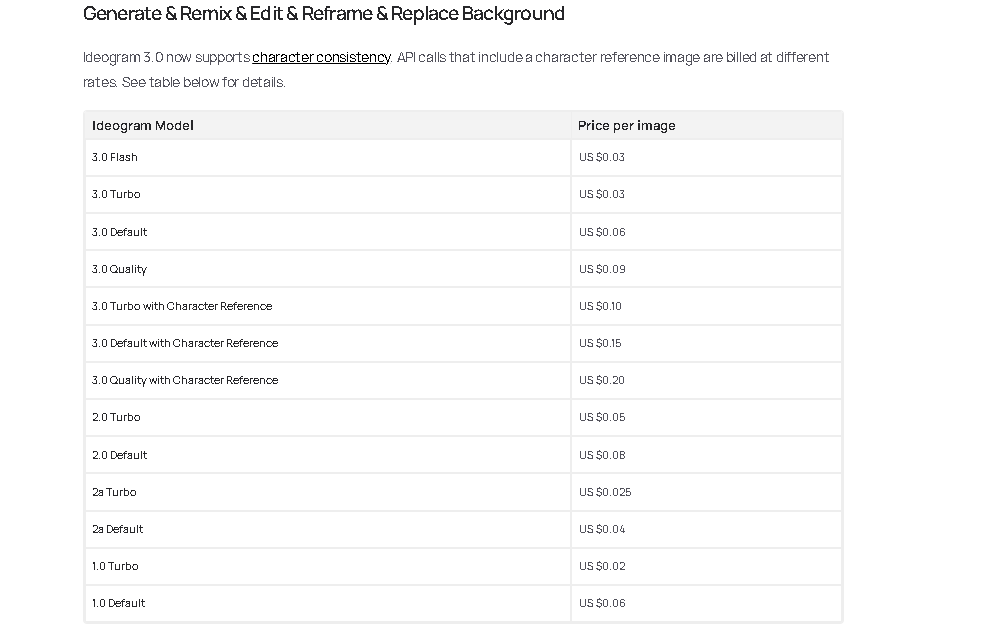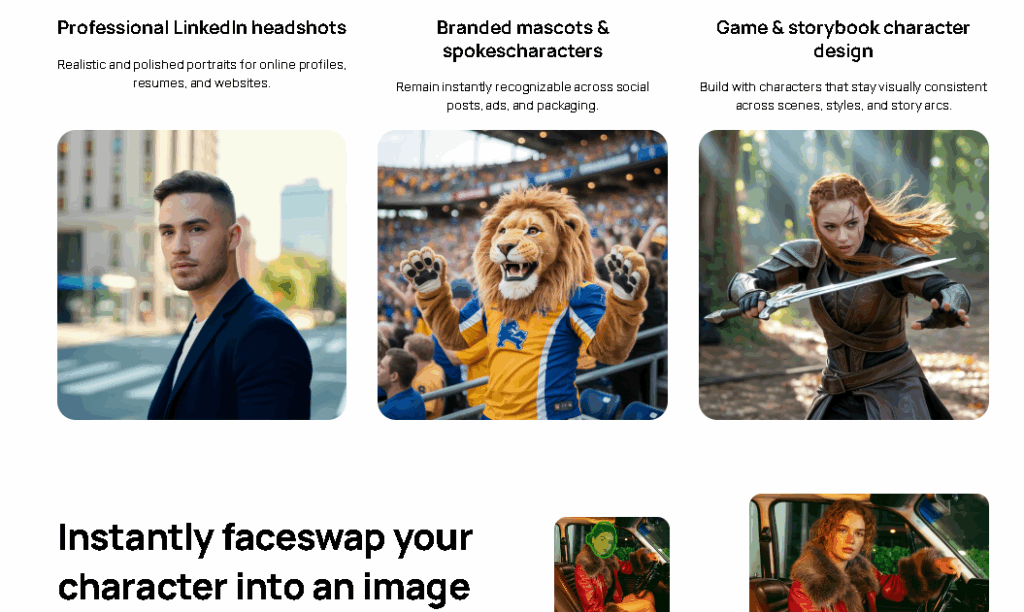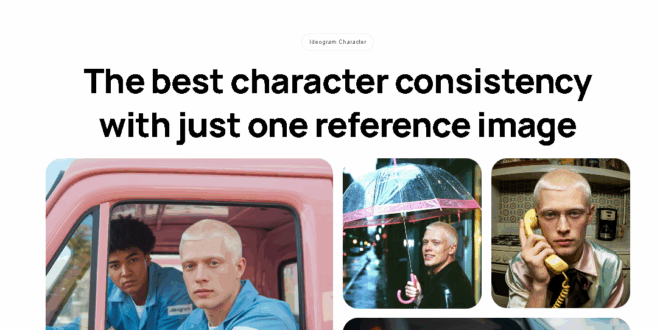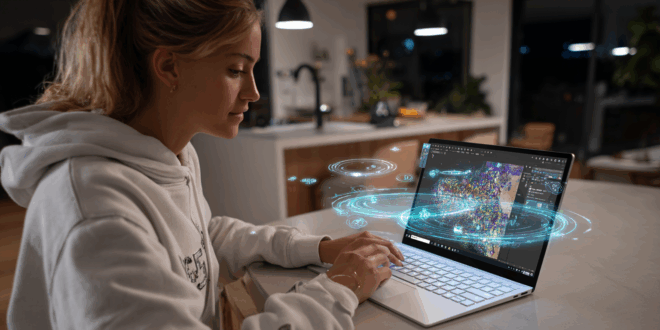29% of digital artists report already using artificial intelligence in their creations. Ideogram Character provides a direct answer for generating coherent characters from a single image. With an API workflow, the platform offers avatars, mascots, and other creations for brand campaigns.
What Is Ideogram Character?
Ideogram Character is a feature of Ideogram, a generative artificial intelligence platform specialized in creating images from text. It ensures the creation and consistent reuse of the same character across multiple generated images. The system relies on the principle of single-image consistency, maintaining the distinctive traits of a reference image, such as hairstyle, expressions, or facial details. This method avoids training specific types like LoRA and speeds up production.
This approach guarantees stable and instantly recognizable characters. It integrates seamlessly through the Ideogram API, making it easy to adopt into creative or professional applications. It also offers high visual coherence, essential for repeated or large-scale use.
A Paid Generative AI Accessible to All
Founded in Toronto in 2022 by former Google researchers, Ideogram AI secured $80 million in Series A funding in February 2024, marking a significant financial milestone. Ideogram AI offers the Ideogram Character feature through its web platform and iOS mobile app for the public. However, unlimited and private access to this character consistency requires a Plus or Pro subscription.
The integration through the Ideogram API presents optimized costs based on the volume, depending on the algorithm chosen by the user. The API pricing significantly increases when the call includes a reference image for the character, reaching up to $0.20 USD per image with Character Reference. However, the free option provides 10 slow credits per week, allowing for limited experimentation that resets every Saturday at 00:00 UTC.
Not ready to spend money? Check out our tips for the best 100% free AIs:
Technologies Behind Ideogram Character
The architecture of Ideogram Character relies on specific technical choices and a massive image corpus that determines its robustness. The joint study of the model and its data illuminates how it balances diversity, performance, and bias control.
Model and Training Data
Ideogram Character is based on the Ideogram 3.0 foundation model. It utilizes a massive proprietary image corpus, which directly influences its robustness and performance. The construction of the annotated dataset must address dataset bias issues to ensure fairness and representation quality. The diversity of styles in the corpus allows the model to transpose the referenced character into various formats, from photorealism to anime.
The use of synthetic data can mitigate biases in training datasets. Incorporating these artificial samples balances the data sets. Consequently, fairness-aware algorithms explicitly correct overrepresented characteristics. The model thus aims to limit biases arising from training on vast collections of unregulated images.
Technical Pipeline and Optimized Formats
The technical pipeline begins with uploading a reference image that serves as the initial conditioning for the diffusion model. The system provides sophisticated mechanisms like Magic Fixup, which allows the insertion of characters into newly generated scenes. Moreover, the model interprets the reference through an internal encoder/decoder mechanism that extracts the permanent features of the face and body to ensure constancy.
Users can adjust a key parameter called Image Weight. This setting determines the precise influence of the source image on the generation. The value is adjustable between 1 and 100, with a default setting of 50. A higher value allows the parent image to exert maximum influence on the final result. Users should supply a high-quality reference image to achieve optimal rendering. The maximum supported resolution for the default square format is 1024×1024 in version 3.0, with optimized marketing formats such as 1536×640 also available.
API and Technical Constraints
The Ideogram API facilitates direct integration of the models into production products and platforms. The interface provides crucial endpoints named Generate, Edit, and Remix for creation, modification, and reuse operations. Access is primarily through a REST API interface. Refer to the article: REST API: everything you need to know about their operation. The tool manages various input and output image formats, both portrait and landscape.
Using the Remix API requires uploading an image file (JPEG, WebP, or PNG) that does not exceed 10 MB. The models show certain limitations in generalization when the character adopts angles significantly different from the original reference. However, the system maintains high-quality controls for photorealism, a strong characteristic of Ideogram 3.0.

Various Applications of Ideogram Character
Ideogram Character stands out as a versatile tool utilized in both creative and professional contexts. It encompasses a wide range of uses: social media, advertising, video games, or e-commerce, all while maintaining strong visual coherence.
Applications for Content Creators
The tool allows influencers and creators to maintain consistency in their personal brand across digital platforms. Visual recognition becomes a key factor in retaining an audience and strengthening identity. Users can quickly generate coherent avatars for their profiles or to illustrate regularly posted stories.
The Magic Fill feature simplifies the instant insertion of the character into a new background. This smooth integration enhances the quality of visuals produced for social media. Furthermore, extensive usage on these platforms boosts recognition and audience loyalty in the face of volume-generated content.
Advertising and Visual Communication
Agencies produce cohesive assets for their advertising campaigns. They can repeat the same character in various formats suitable for different geographic contexts. The tool enables rapid testing of concepts, outfits, or environments without incurring expensive photoshoots.
The ability to ensure clear typography in images directly supports the creation of effective banners and captions. This visual precision enhances the impact of advertising messages, enabling teams to work faster and more flexibly in designing their materials. Advertising is no longer the same with the advent of AI. See why and how!
Businesses and Large-Scale Production
Businesses simplify the production of visual content through the AI tool. They can target multiple demographics and promptly adapt their messages, promoting more precise and better-segmented communication. The precise textual rendering constitutes a major asset for captions and marketing materials. Thus, the speed of iteration reduces production costs, allowing teams to optimize their resources while maintaining consistent quality.
Video Games and Visual Storytelling
Ideogram Character finds a natural application in the creation of assets for video games. These elements, known as game assets, enrich interactive worlds. Creators also generate variations of characters for webcomics or animated series.
Development teams use the tool for rapid prototyping of main and secondary characters. This approach speeds up the pre-production phases. Consequently, character constancy becomes essential to maintaining narrative immersion credibility. Did you know that AI can create a video game from start to finish?
Product Design and E-Commerce
Design teams leverage the tool for quick prototyping of products. They can rapidly test ambient or outfit concepts to validate creative directions. This agility fosters innovation and reduces design timelines.
The e-commerce sector generates realistic product mockups. It inserts coherent human figures wearing the items for sale in various scenarios. The flexibility of Remix allows adapting the style of an existing image to a new context. Furthermore, this rapid execution facilitates design validation before physical manufacturing.

Alternatives to Ideogram Character
Ideogram Character competes directly with other major avatar generators and AI-assisted image studios. It stands out particularly for its fidelity. The Midjourney platform focuses more on overall artistic aesthetics and struggles to maintain character detail consistency across prompt iterations. Furthermore, Ideogram differentiates itself with its superior handling of text rendering within images.
This field requires fast and precise models for the professional market. Stable Diffusion offers maximum flexibility and allows for the training of custom models, like LoRA. However, integrating Stable Diffusion often demands a high level of technical expertise and necessitates training heavy and complex models.
Ideogram’s approach circumvents these lengthy processes by employing a single reference image. The competition intensifies with the arrival of robust platforms. Stable Diffusion 3 indeed surpasses its predecessors in adherence to prompt guidance and typography, positioning itself against Ideogram v1.
Similarly, DALL-E 3 has updated its capabilities to ensure much more accurate text rendering, addressing previous shortcomings. Additionally, the Playground v3 model excels in graphic design and is adept at managing multilingual understanding and complex reasoning.
Articles by the same author:
Qwen-Image: What to Know About This Advanced Model for
Meta Dino v3, a Self-Supervised Vision Model from
Discover Microsoft POML, the Markup Language for
Everything About Grist, a Collaborative Tool to Know






